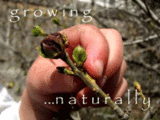I got interested in gardening not because I had any desire to get my hands dirty, but in reaction to
reading a
number of
studies that
show that the
nutrition in fruits and vegetables has been
falling over the last 50 years. Organic or not, most commercially available vegetables contain significantly lower levels of vitamins and minerals than they did before WWII.
The main reason seems to be that for the most part, our industrial methods of farming have depleted the soil of the nutrients needed to create grow truly optimal crops. Before WWII, most farmers used composts from their own land and manures from their own pastured livestock to re-nourish the soil every year.
After WWII, chemical companies that had been founded to support the war effort moved to making agricultural products. Using NPK fertilizers replaces the nutrients that are most quickly used up, and for a few years it seemed that they were a real boon -- plants grew bigger and faster than they had before with far less effort. But the NPK fertilizers (Nitrogen, Phosphorus, and Potassium based fertilizers such as Miracle-Gro) don’t replace the minerals the plants take from the soil, and so after years of replacing only a few of the nutrients and shipping the produce off the farm the soils are left badly depleted.
What isn’t in the soil, can’t be in the foods we grow on those soils.
That bothers me. How can we be truly healthy if the foods we eat aren’t supplying the nutrients we need?
I have been fascinated by nutrition since the day I discovered Adele Davis, back in the 1970s, and I’m a “do it yourself” kind of person, so I figured that the way to deal with this revelation was to take matters into my own hands. For a long time, I took lots of vitamins, but when we bought our house, with its nice big yard, I knew it was time to try growing our own food.

As I researched how to grow food with the best possible nutrition, one thing that became clear. If the nutrients aren’t in the soil, they can’t be in the food grown on that soil, so it stands to reason that the place to start is in nourishing the soil.
Traditional organic gardening has a great many advantages over industrial gardening. It relies primarily on composts for nutrients, and compost has a far broader range of nutrients than the industrial NPK fertilizers, so it will make for far healthier, much better tasting vegetables than those grown with industrial methods. But compost grown on depleted soil is also depleted, and anything grown on depleted soil is not maximally nourished, and so isn’t an ideal source of nourishment for the soil.
There are a few exceptions, of course; plants with exceptionally deep root systems can bring up minerals from deeper in the earth and make it available on the surface. Those composts are unusually rich in nutrients. Sea sources of compost are generally less depleted than land sources, since the nature of water is that it “mixes it all up” far more than soil does, and minerals are more available to everything growing there.
I learned, too, that soil can be a living entity. Little grows and less thrives on dead soil. Food grown on poorly nourished soil is more susceptible to predation and the produce is smaller, spoils more easily, and tastes more bitter than its well-nourished kin.
Of course, the best starting place for really well nourished soil would be a soil test. At $50 per plot/test, it’s not super expensive, but I have not had the funds to have the testing done and also to buy the soil amendments in the same year, so I have approached high nutrition gardening rather more haphazardly.
I looked into what amendments had the broadest range of nutrients and then approached the garden soil much like I do my own diet -- I worked toward a balanced combination that should be able to add back anything that’s missing without going too heavily into any one nutrient. It’s not ideal, but even so, my results were amazing the first year.
Since I didn’t know what was missing from my soil, I mostly didn’t use single nutrient amendments to begin with. Instead, I opted for composted cow manure, alfalfa meal, rock dusts, bone meal, blood meal, kelp meal, and fish meal, with a foliar spray of fish emulsion. They all have a broad array of nutrients and they each have their own balance.
The first year, I went all out: I double-dug the garden bed and put in large amounts of amendments and then spent the summer foliar feeding weekly, creating “cow poop soup” and applying that weekly. Our results were amazing! We had a tiny garden that year, but the produce was never ending! It was big, sweet, tender, and it lasted for weeks and weeks and weeks on the counter -- a good thing because our tiny garden produced far more in a week than we could eat . That bed still out-produces any other bed we’ve put in -- perhaps only because it’s perennially has the longest history of being re-nourished.
The next year, we expanded the garden a bit and I put in a few amendments, but then we took a trip in early spring. I didn’t do much more that year and our produce was sparse but tasty.

Last year, we expanded a great deal -- doubling the size of the garden. I triple dug the beds with the full array of amendments, and then applied cow poop soup and foliar feed weekly until July, when I became too ill to get out of bed, much less garden. We still had a huge harvest of really good tasting vegetables, but they didn’t last well.
This year, we have added the amendments and I am branching out into more single nutrient experiments. (Silica, magnesium, oxygen, etc) I have applied cow poop soup and foliar feed, though not as conscientiously as I did that first year, though I am working to improve my commitment. My plan is to foliar feed every week and add cow poop soup every week from now through fall.
I now have a refractometer, too, which I may be able to use to tell when I have hit on the right balance of nutrients. So far our Brix readings have been mixed. The total brix percentage hasn’t been impressive, but the extreme fuzziness of the readings suggests a well nourished plant with a good mix of nutrients -- the low-ish readings may simply be due to one thing that the plant is missing for superb health. Now I can experiment using feedback that won’t require waiting to taste the produce.
I am far from any kind of expert, but I have seen the difference the extra nutrients make and I wouldn’t go back to simple organic gardening knowing what I have seen.
Will it make us healthier? Maybe. But the vegetables sure taste and last better and that’s worth the investment.
Coming soon, specifically for Master White: how we do what we do.











































